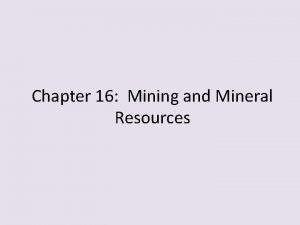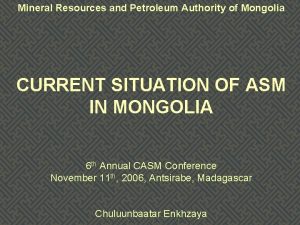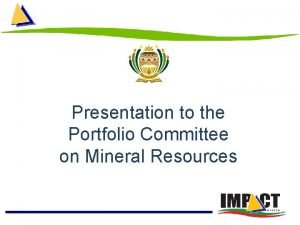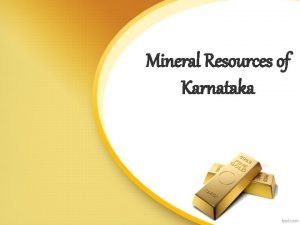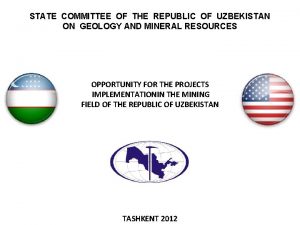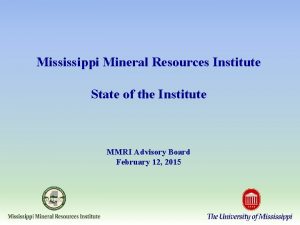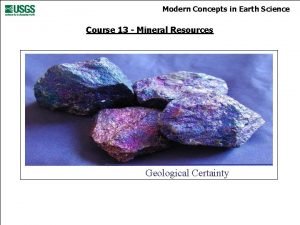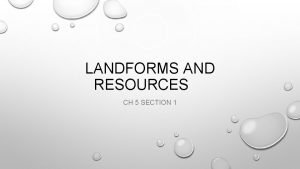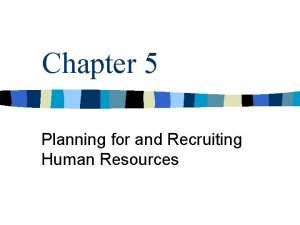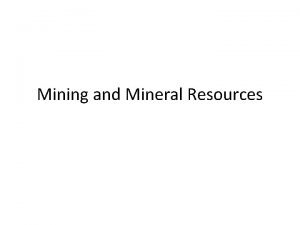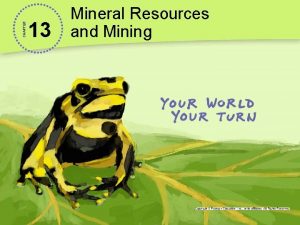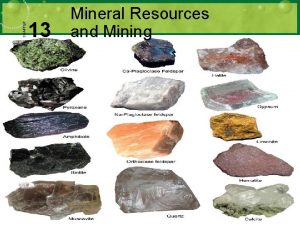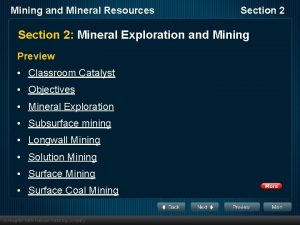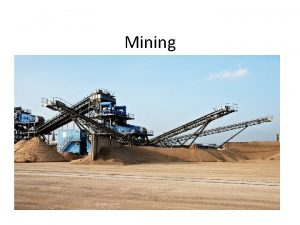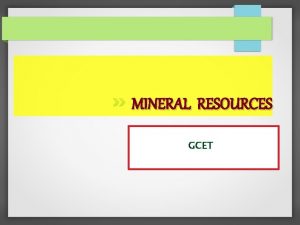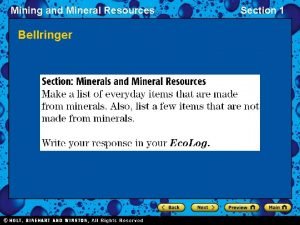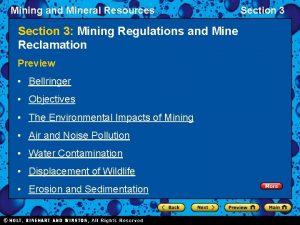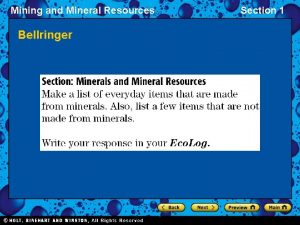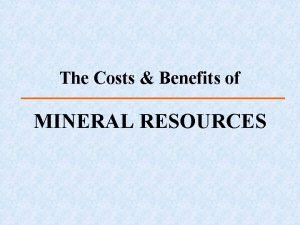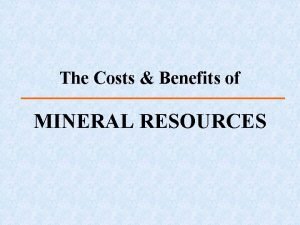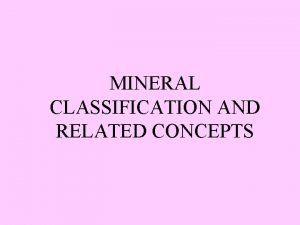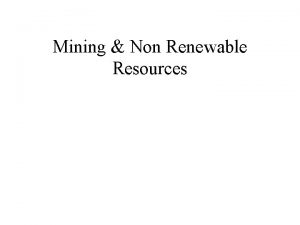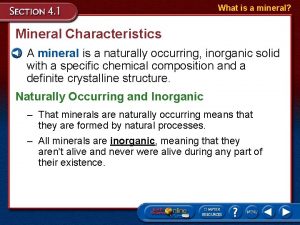Mining and Mineral Resources Chapter 16 1 Mineral





















- Slides: 21

Mining and Mineral Resources Chapter 16 1

Mineral Resources • We depend on the use of mineral resources in almost every aspect of our daily life. • However, our dependence on minerals has not come without a price. • The current challenge is to obtain the minerals that an ever-increasing world population demands at minimal cost to the environment. 2

What is a Mineral? • A mineral is a naturally occurring, usually inorganic solid that has a characteristic chemical composition, an orderly internal structure, and a characteristic set of physical properties. • They can be made up of a single element or be a compound (atoms of two or more elements bonded together). 3

Ore Minerals vs. Gangue Minerals Ore Minerals Gangue Minerals • Minerals that are valuable and economical to extract • Mining companies have to separate the ore from the gangue. • Minerals that have no commercial value • For mining to be profitable, the price of the final product must be greater than the costs of extraction and refining 4

Section 16. 2 • Mineral Exploration and Mining 5

Mineral Exploration The first step is to explore rock for mineralization. Rock samples are then taken from the area. Ore grade is then determined. If the ore grade is high enough, the company will drill test holes. • Lastly, if the deposits are extensive enough, opening a mine may be warranted. • • 6

Subsurface mining • This method is used if ore deposit is found 50 m or more beneath Earth’s surface. 7

Surface Mining • Used when ore deposits are located close to Earth’s surface. 8

Solar Evaporation • This involves placing sea water into enormous, shallow ponds where the sun evaporates the sea water; Salt crystals form and are harvested 9

Placer Mining Dredge • Placer gold and diamonds are • Placer deposits are mined by dredging. surface deposits where minerals are concentrated • A dredge is a floating barge on which buckets fixed on a by wind and water. conveyor are used to separate • Minerals fall to the minerals from the sediment. streambed and become Processed sediments are discharged behind the dredge. concentrated and can be removed by dredging 10

Undersea Mining • Several attempts have been made to mine the ocean since 1950 s. • It is more expensive than land mining and deep ocean depths are two reasons undersea mining has not been successful. • Mineral resources contained in ocean floor include gold, silver, diamonds, mineral ores, and sand gravel. 11

Section 16. 3 • Mining Regulation and Mine Reclamation 12

The Environmental Impacts of Mining • • Surface mining can cause both air and noise pollution. Dust is created in all parts of the mining process. Noise is created by the equipment and blasting. Due to these environmental impacts, most surface mines are not located near urban populations. 13

Water Contamination • Water that seeps through mines can pick up substances like arsenic. • Contaminated water from AMD or acid mine drainage happens when sulfur reacts with oxygen and water to form sulfuric acid. 14

Displacement of Wildlife • Removing soil due to mining strips away all plant life. • This causes animals to leave the area. • Once the soil is replaced, different plants and animals may live there. • Dredging displaces aquatic wildlife 15

Erosion and Sedimentation • Excess rock from mines is sometimes dumped into large piles called dumps. • Running water erodes dumps. • Sediment may harm water quality and aquatic life. 16

Soil Degradation • If soil is not removed and stored in separate layers, the soil may be nutrient poor when it is reclaimed. • When some minerals like sulfur are exposed to water and oxygen, the soil acidifies. • This makes it difficult for plants to grow. 17

Subsidence • The sinking of regions of the ground with little or no horizontal movement. • Occurs when pillars collapse or the mine roof/floor falls. • It can cause property damage and force people to evacuate their homes. 18

Underground Mine Fires • One of the most serious environmental consequences of coal mining. • Can be caused by lightning, forest fires, and burning trash. • Hard to put out; left to burn themselves out. • If they reach surface, can lead to respiratory problems. 19

Mining Regulations and Reclamation • Clean Water Act and Safe Drinking Water Act ensure contaminants from mines do not threaten water quality. • Comprehensive Response Compensation and Liability Act regulates hazardous substances released in air, soil, and water. • All mining operations must comply with Endangered Species Act to ensure mining will not affect threatened or endangered species. 20

Reclamation and Regulations Reclamation State Regulation of Mining • Returning land to its original or better condition after mining. • Surface Mining Control and Reclamation Act of 1977 minimizes the surface effects of coal mining. • Mining companies must obtain permits from state agencies before mining. • In some states, a mining company must post funds called a bond before mining begins. • States also inspects mines. 21
 Strip mining before and after
Strip mining before and after Mineral exploration and mining active reading
Mineral exploration and mining active reading Difference between strip mining and open pit mining
Difference between strip mining and open pit mining Difference between text mining and web mining
Difference between text mining and web mining Mineral resources and petroleum authority of mongolia
Mineral resources and petroleum authority of mongolia Portfolio committee on mineral resources and energy
Portfolio committee on mineral resources and energy Strip mining vs open pit mining
Strip mining vs open pit mining Multimedia data mining
Multimedia data mining Eck
Eck Minerals of karnataka
Minerals of karnataka Uzbekistan mineral resources
Uzbekistan mineral resources Mississippi mineral resources institute
Mississippi mineral resources institute Vms deposits
Vms deposits What is the transformation process
What is the transformation process Variable resources examples
Variable resources examples Renewable vs nonrenewable resources worksheet
Renewable vs nonrenewable resources worksheet Chapter 24 the land where continents collided answer key
Chapter 24 the land where continents collided answer key Southwest asia landforms
Southwest asia landforms Landforms and resources section 1 answer key
Landforms and resources section 1 answer key Chapter 8 study guide human resources culture and diversity
Chapter 8 study guide human resources culture and diversity Chapter 8 study guide human resources culture and diversity
Chapter 8 study guide human resources culture and diversity Chapter 5 personnel planning and recruiting
Chapter 5 personnel planning and recruiting

